|
Log time no post! It has been a whirlwind the last couple years as I tried to enjoy the end of my son's high school career, then seeing him through signing and off to college. I will begin posting things again throughout the offseason. Below is a quick snippet from a video course I did on CoachTube. The section talks about assembling/ tweaking pass patterns to get easy completions.
0 Comments
As Part 3 of Developing an Offensive System nears its release date, I wanted to write about some adjustments in the way we package that have proven to be very beneficial in the past year. Late last fall, I began to adjust game plan forms in order to make it easier to recall options in the heat of battle. This spring, six primary "structures" were labeled on the coach's sheet: We derived this terminology to make the teaching for all players easier; it also allows the offense to move around star players with no additional learning burden. The Read/ Navigation tags allow the coach to guide the passer to the easiest lane of completion. By classifying game sheets, the playbook, and cut ups by route structure, one can be extremely efficient - with an offense can now teach minimal techniques and assignments, but apply in several different ways to attack a defense. Most of all, the QB and coach can benefit from the ability to hit all eligible receivers in a pattern. To illustrate, we will look at a few clips involving the drag route. First, the basic DRIVE: Next, the 9 route in front of DRIVE: Lastly, using the 9er (Numbers) advantage principle:
Homer Smith taught us all that nothing can become more entangled than patterns, protections, and formations. To this, we must add read types, as merely having one way to read a pass defense severely limits the ability of an offense to attack. This system, as it is constructed, meets all those needs, though the number of combinations can seem overwhelming. By simply grouping structures as a means to help coaches process and assimilate the weapons at their disposal, we are able to keep the offense in manageable pieces, maximizing learning and execution.
Things are hectic, as Part 3 of the iBook Series is days away from being available. I have gotten a ton of email and messages with questions, and wanted to take the time to address. I really do try to reply in a timely manner, but sometimes schedules and deadlines prevent me from doing so. So - here are a few teaching clips that will help answer some questions. Most of them are directly from our QB Manual... BURST video: As you can tell from the clips, these ideas have been in place for a while. The important thing is that the coaching points and techniques remain the same, despite different play terminology. "Scanning into IN routes": A couple weeks ago, the #1 ranked 5A team in Missouri squared off with the #1 ranked 6A team in the state. The 5A team prevailed that night, 35-21. I am admittedly biased, as the 5A Fort Osage Indians are a client of mine.
I asked their coach, Ryan Schartz, if he'd write a bit on how they have benefited: Last winter my offensive staff and I knew we had a group of players suited to throw the ball. Our run and shoot system was by no means broken, but it did limit some of the the things we wanted to be able to do. After reading Dan's book Re-coded and Reloaded, it dawned on me that this was the system to use. Installment started in the spring and continued into the summer. The language that he uses allows players to learn quickly. Our kids have commented several times that it is much easier to learn than our former system. His system was an easy transition as it has many run and shoot concepts built in. One of our main objectives was to be able to get our RBs out in to routes out of the backfield. The Gonzalez system more than allows an offense to use all 5 receivers. The best part, though is the rhythm passing and progression allows the QB to make his reads quick and decisive. After using parts of it for the first 3 weeks of the season, we have noticed that there is much flexibility in attacking defenses. This is all coming from at team that traditionally runs the football 80% of the time. Dan has been terrific! He is readily available to help explain and give advice. Although we have not changed much of our run game, his passing system has been a wonderful resource for our program. Ryan Schartz Head Coach Fort Osage High School Independence, MO After numerous technical challenges, I am happy to announce that my new ibook, Coaching Concepts: Developing an Offensive System is now available. It was a long road, but it will be worth it. The content is dynamic, with over an hour of video embedded. Most of all, information such as "Navigation Tags" will help your offensive system RIGHT NOW, without changing the system you are installing. Thought I'd try this once, and see how it came out. Hopefully the volume came out OK, so you can get the coaching points as I run the video. I am very excited to announce that I am partnering with Coaches Edge Technologies to create a series of iBooks that will give more depth to the system I have put together. The product will resemble the great work of Keith Grabowsky, where video, animated presentations, and voice overs are combined to give the coach greater understanding.
Hindsight is 20/20. We know this, but we also know that those who do not learn from the past are doomed to repeat it. As I look back on the past Super Bowl, I am reminded of things I learned in a pro-style offense decades ago, yet can be forgotten with the preponderance of today's spread thinking. Going into the game, much of the talk of the Denver Offense vs. Seattle Defense conversation was the high percentage of "Cover 1" the Seahawks' defense would play. Many agreed that Peyton Manning's penchant for getting the ball out quickly would help negate Seattle's defensive prowess. Looking back, however, one wonders if this thinking helped play into Seattle's hands. In the diagram above, we have a vanilla interpretation of the Cover 1, which is defines as man to man with 1 free safety deep (also called "Man Free" in football vernacular). The corners can play press, off, or "bail" in order to disguise their intentions. There is always an extra underneath defender (the M in the diagram) who can blitz, wall off crossing routes, or simply be a pest the QB must throw around. More on that in a bit. Initial examination will call for getting the ball out quickly, on flat or drag routes -- often in some "mesh" configuration. Some forms of offensive thinking will depend solely on quick routes versus this defensive structure. Superior match-ups may allow for this, but the defense can counter vs. a limited arsenal, and pounce when they see a familiar pattern. The big hit on Demarius Thomas was proof of this: Cam Chancellor, the frontside safety (F), rolled down in a version of 1 Robber. His depth allowed to track the shallow and make a big hit. Further examination, however, shows Eric Decker WIDE OPEN on his in cut. Had the progression called for scanning INTO the in route, as we teach, he would have seen the open route, as well as seeing Chancellor because his eyes would start in front on the flag by A (Wes Welker) and swing into the route. Homer Smith introduced this idea to me years ago, and it still resonates today -- our eyes jump (or "saccade") from one spot to the other; carefully planned progression passing should take the passer to these routes not only so he can see the "danger" out in front. Navigation Tags, as described here, are primarily for helping with zone completions (a coach needs the ability to direct his player on every snap based on game and coverage situations); defeating man coverage necessitates maintaining all possible options on a pass play. As a collegian, the defense I saw every day in practice played press man on a majority of the snaps; here is what I know about beating man to man -- while rub/ mesh routes are great, there is no substitute for attacking with depth. The FLAG route might be the best of all routes vs. this coverage. However, a limited set of routes once again gives the defense an advantage. In another example, the Broncos are in the Scoring Zone. They have a Post/ Wheel combination to the left, with spacing/ comeback to the right. The defense shows Cover 1, then actually bails to a combo coverage, playing zone on the post/wheel side and man to man against Welker on the right side of the formation. Below, you can see the ball is already coming out -- and the potential danger awaiting. This is an example of why the ball coming out in the same rhythm (even quick rhythm) all the time is a potentially bad thing. If the only objective of the offense is to get rid of the ball quickly, this actually plays into the hands of the defense, as cover men are not stretched to the limits of their abilities. It simply takes less talent to cover for a short period of time. For this reason, deep ins/ outs are a MUST when defeating man coverage. Depth makes a man defender, no matter how talented, turn their hips and run. Even in this one-sided Super Bowl, the Bronco's positive plays came on deep crossing routes and ins/ and outs. Below, on the same play as above, look at the comeback route at the top of the screen. The ball being gone is irrelevant; the corner covering has no idea the ball has been thrown. Make no mistake - the game was, as they say in my hometown of Paris, TX -- "a whoopin''". The Seahawks were a more physical team, and the nature of the Denver running game didn't help, as it was too dependent on box counts rather than calling and running plays, regardless of the defensive look. Protection was a major issue, but the defense had as many pressures when in zone as they did in man; the coverage does not add time on a given play, just as adding a check-releaser (from 6-man to 7-man, for example) has no effect. Protection time can be gained with carefully programmed scan and help calls. The paradox was the plan of quick completions vs. what actually disturbs man coverage.
The premise remains: in attacking man coverage, explosive plays are a must, and are not always available when solely releasing the ball in quick rhythm. I have a few projects in the works, so my time has been divided. I have, however, received a lot of questions in regard to how the traditional QUICK game fits into the verbiage described in Recoded and Reloaded. So, here is a short write-up. First, in regard to how we CALL these pattern sides, they are NAMED routes that fit into the backside of the numbered frontside pattern. For those who are unfamiliar with our play calling system.....go buy the book. Just kidding. Below, you can see a diagram giving a brief explanation: The patterns are described just as in many systems: HITCH, OUT, or FIST (Flat Inside a SlanT): We tag these patterns with the NUMBERS (9ER) Advantage Principle, in which we have a pattern to attack single high or soft corners, and a default Cover 2 pattern to the frontside. We will plan our quick side to defeat single high, while the 220 pattern offers a solid choice vs. Two Deep. One benefit to the high school or college hash marks is the ease with which true two deep can be surmised: with the ball on the hash, as in the diagram above, the BACKSIDE safety (B) must play on or outside the hash in in order to be a half field player. Regardless of where F (front side safety) aligns, if B plays inside the hash, we will treat the alignment as single high.
As a result, the QB's decision is simple and decisive: if the safety is inside the hash, he can count on single high principles to the tagged quick route; if he is on or outside the hash, he works the "220" pattern. The accountability falls to the coach to carefully plan boundary and field formational looks, but the work for the QB is clearly defined with an Advantage Principle that not only facilitates the quick game, but this offense's version of the Run N Shoot "Choice" route as well. This represents the most basic presentation for quick routes. Hope this helps! |
AuthorLiving in Allen, TX and using this outlet to not only stay close to the game I love, but to help pass on what I have learned from some of the game's great coaching minds. Categories
All
Archives
July 2021
|

|
|
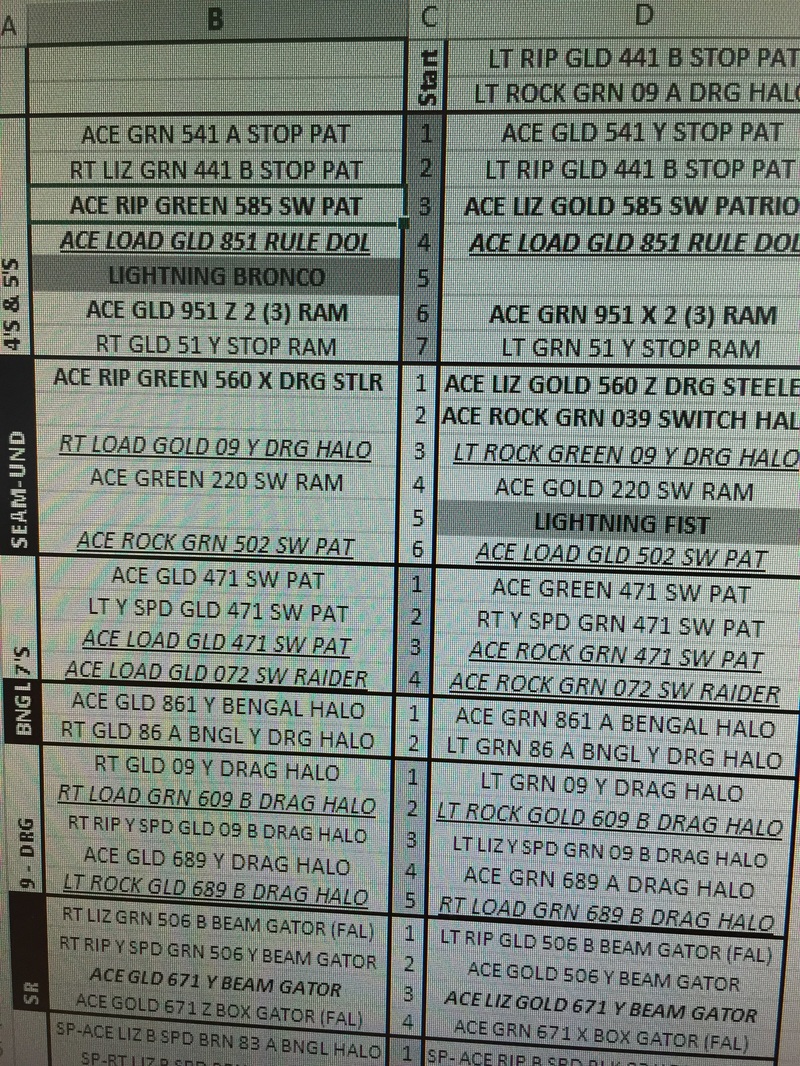
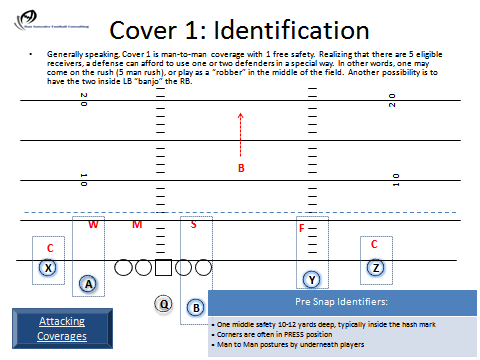
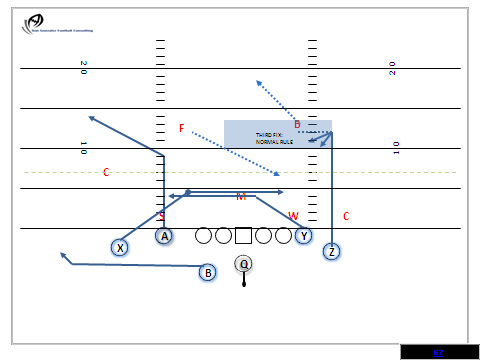
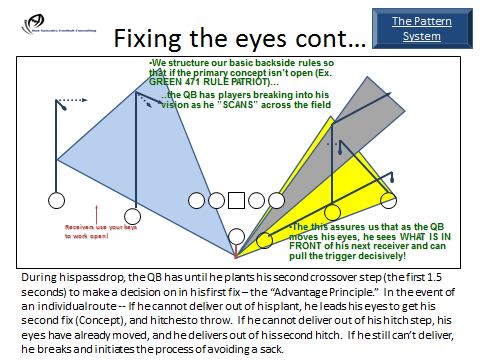
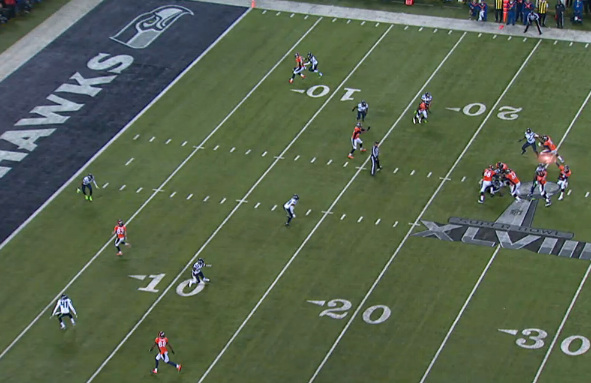

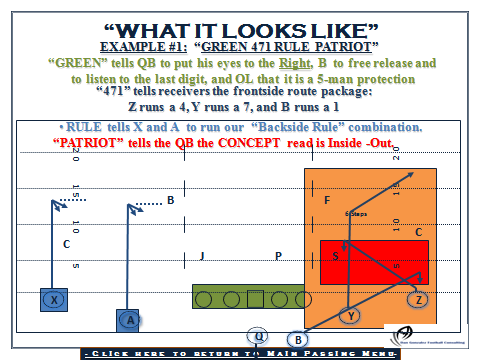

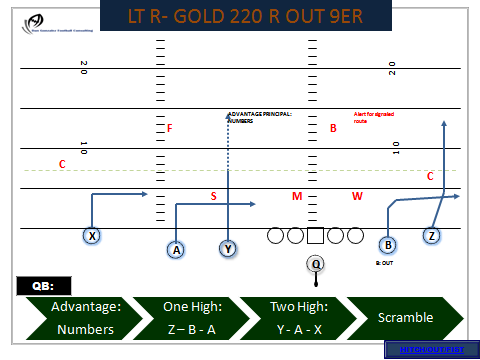
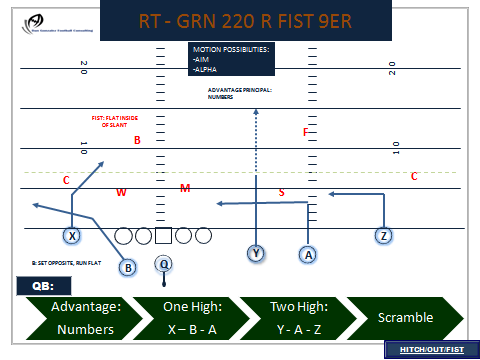

 RSS Feed
RSS Feed
